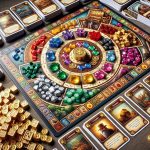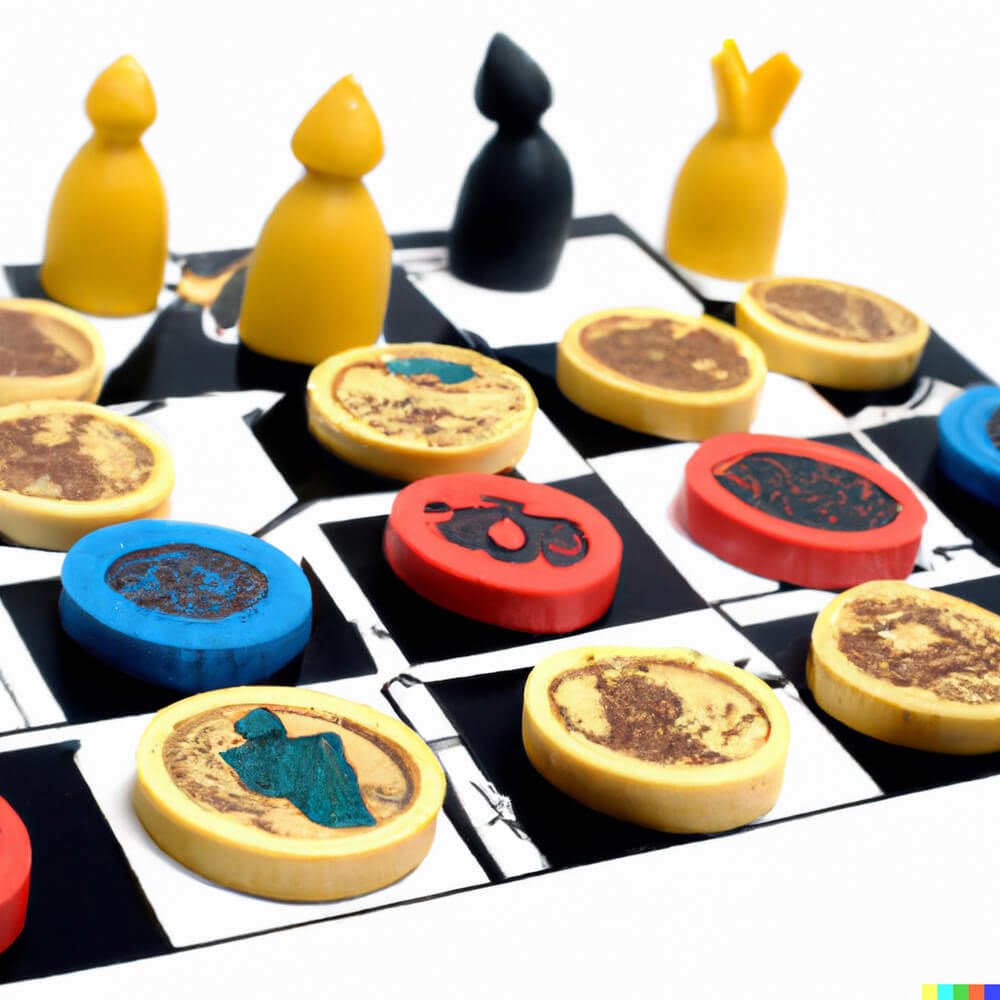Is there a strategy for Splendor board game? Splendor is a popular, fast-paced board game that requires players to collect gem tokens in order to purchase development cards and ultimately earn prestige points. Understanding the game’s objective and the various player strategies can greatly increase your chances of winning. In this article, we will explore the different components of the game, analyze the resources available, and discuss tips for developing a successful strategy.
Splendor is a strategy-based board game designed for 2-4 players, where each player takes on the role of a wealthy merchant during the Renaissance. The goal of the game is to attain 15 prestige points before your opponents by purchasing development cards using gem tokens. With simple rules and elegant gameplay mechanics, Splendor has gained a following among board game enthusiasts worldwide.
To excel at Splendor, it is essential to understand the objective of the game, which involves strategically collecting gem tokens to purchase development cards and attract nobles for additional prestige points. By analyzing the game components and resources available, players can develop an effective strategy that will lead them to victory. This article aims to provide an in-depth analysis of different player strategies and offer valuable tips for maximizing your chances of success in Splendor board game.
Understanding the Objective of the Game
The objective of the Splendor board game is to become the most prestigious and wealthy merchant in the Renaissance era by acquiring gem mines, transportation, and shops along with attracting the attention of nobles. Players compete to collect valuable gem tokens, purchase development cards, and attract noble patrons to earn prestige points with the goal of reaching fifteen points first.
To achieve this objective, players must strategically manage their resources and carefully plan their actions. Successful players will have a clear understanding of the game’s mechanics and be able to adapt their strategy as the game progresses.
Understanding the objective of Splendor is crucial for developing a winning strategy. Players must focus on earning prestige points through purchasing valuable development cards, attracting noble patrons, and efficiently managing their resources throughout the game. Since every action in Splendor affects all aspects of gameplay, it is essential for players to think ahead and consider the long-term impact of each decision they make.
In summary, understanding the objective of Splendor is key to developing a successful strategy in this board game. By prioritizing prestige points while effectively managing resources and planning ahead, players can increase their chances of becoming the most prestigious merchant in the game. Each strategic decision made throughout the game should be focused on gaining an advantage over opponents and ultimately achieving victory.
Analyzing Game Components and Resources
Splendor is a game that combines the elements of resource management and card development. In order to understand the strategy for winning the game, it is important to analyze the different game components and resources available.
Understanding Game Components
The game consists of several components including gem tokens, development cards, noble tiles, and prestige points. Gem tokens are used as currency to purchase development cards while development cards are used to earn prestige points. Noble tiles can be claimed by players who have certain combinations of development cards, earning them additional prestige points.
Resources in Splendor
There are four different types of gem tokens in Splendor: emerald, sapphire, ruby, and diamond. Each type of gem token is used to purchase specific development cards, which have varying costs and prestige point values. Understanding how to efficiently collect these gem tokens and use them to obtain development cards is key to developing a winning strategy.
Strategic Use of Resources
Players must carefully consider which gem tokens to collect in order to acquire the most valuable development cards. It can be beneficial to focus on obtaining certain types of gem tokens that align with valuable or high-point value cards. Additionally, managing gem reserves and strategically reserving specific cards for later purchase can also play a crucial role in developing an effective strategy for winning the game.
In analyzing the game components and resources in Splendor, it becomes clear that strategic decision-making regarding gem token collection and card acquisition is pivotal in achieving success in the game. Understanding how these components interact and utilizing them efficiently will greatly impact a player’s ability to develop a winning strategy.
Exploring Different Player Strategies
When playing the Splendor board game, players have a variety of strategies they can employ to increase their chances of winning. The game offers different paths to victory, and it is essential for players to explore and understand these strategies to make informed decisions during gameplay.
Developing an Engine
One popular strategy in Splendor is the development of an engine. This involves focusing on acquiring cards that provide ongoing benefits, such as discounts on future purchases or additional resources. By building an engine, players can efficiently accumulate the necessary resources to purchase higher-value cards and ultimately win the game.
Rush Strategy
Another approach that some players take is the rush strategy. With this tactic, players focus on quickly purchasing the lowest level of development cards in order to gather prestige points as fast as possible. While this strategy can be effective in certain situations, it requires careful planning and resource management to ensure success.
Balance and Adaptability
Some players prefer a more balanced approach, adapting their strategy based on the available cards and resources throughout the game. This flexibility allows them to respond to changing circumstances and take advantage of opportunities as they arise. In a game like Splendor where luck plays a role, adaptability can be a valuable trait for players seeking victory.
Ultimately, there is no one-size-fits-all strategy for success in Splendor. Instead, players must carefully consider their options and adapt their approach based on the specific game situation. Understanding different player strategies can help individuals develop their own tactics and increase their chances of achieving victory in this engaging board game.
Tips for Developing a Winning Strategy
Developing a winning strategy for the Splendor board game is essential if you want to outplay your opponents and emerge victorious. With the right approach, you can effectively build your gem reserves, acquire valuable development cards, and ultimately earn the most prestige points to secure a win. Here are some valuable tips for developing a winning strategy in Splendor:
- Focus on Gem Reserves: At the beginning of the game, it’s crucial to prioritize building a strong reserve of gem tokens. This will give you the flexibility to purchase development cards more easily and efficiently as the game progresses.
- Strategic Card Purchases: When selecting development cards, consider their point value and how they contribute to your overall strategy. It’s important to aim for high-point cards that also provide gem discounts for future purchases.
- Diversify Your Gem Collection: While having a strong reserve is important, it’s also beneficial to diversify your gem collection. This will allow you to pursue various development card options without getting stalled by a lack of specific gems.
By implementing these tips and adapting them to your gameplay style, you can increase your chances of developing a successful strategy for winning at Splendor.
Remember that each game presents unique challenges and opportunities, so don’t be afraid to adapt your approach based on changing circumstances during gameplay.
With these strategies in mind, you can approach each game with confidence and work towards achieving victory in Splendor. Whether you prefer focusing on card reservations or pursuing noble patronage, having a clear strategy is key to success in this engaging board game.
Evaluating the Importance of Card Reservations
Splendor is a popular board game that involves strategic planning and resource management. One essential aspect of developing a winning strategy for Splendor is evaluating the importance of card reservations. In this section, we will explore the significance of reserving cards in the game and how it can impact your overall strategy.
Reserving cards in Splendor allows players to set aside a card from the tableau for future purchase. This action is crucial as it not only prevents opponents from acquiring valuable cards but also contributes to achieving specific objectives and ultimately winning the game. Here are some reasons why card reservations play a vital role in your strategy:
- Blocking Opponents: By reserving a card, you can prevent your opponents from obtaining it, especially if they are working towards acquiring the same type of card to fulfill their objectives.
- Strategic Planning: Reserving a card gives you time to plan your next moves and gather the necessary resources to eventually purchase the reserved card, contributing to your overall strategy.
- Fulfilling Objectives: Certain objective cards may require specific colors or types of cards to be acquired. Reserving a card that aligns with these objectives can set you on the path towards meeting those requirements and earning prestige points.
In essence, strategically reserving cards in Splendor can give you a competitive edge by disrupting your opponents’ plans, contributing to your long-term objectives, and ultimately leading you closer to victory. Understanding when and which cards to reserve is pivotal in creating a successful gameplay strategy.
Overall, mastering the art of reserving cards effectively requires careful planning, foresight, and adaptability. It’s crucial to assess the potential benefits of each reserved card in relation to your overall strategy while also considering its impact on blocking opponents or fulfilling specific objectives. With strategic reservation decisions, players can gain a significant advantage in pursuing their goals and securing victory in Splendor.
Discussing the Role of Nobles and Prestige Points
The role of nobles and prestige points in the Splendor board game is crucial to understanding how to develop a winning strategy. Nobles are key figures in the game that players must attract to gain prestige points, which are essential for achieving victory. In this section, we will delve into the significance of nobles and prestige points and how they can impact your overall strategy in Splendor.
Nobles are represented by tiles in the game, each depicting a different noble character along with specific resource requirements. When a player has acquired the necessary resources as depicted on a noble tile, they can attract that noble to their side, earning them a number of prestige points. The key strategy is to focus on acquiring the resources required by the nobles that provide the most prestige points, as this will give you an edge over your opponents.
Prestige points serve as the primary method for determining the winner of Splendor. It is important for players to prioritize acquiring these points throughout the game in order to secure victory. There are various ways to earn prestige points in addition to attracting nobles, such as purchasing development cards and building your gem reserves. Understanding how to effectively accumulate these points is vital for developing a successful strategy in Splendor.
| Nobles | Prestige Points |
|---|---|
| Represented by tiles | Determine the winner |
| Attract using specific resources | Earned through various methods |
Common Mistakes to Avoid in the Game
As a popular and engaging strategy game, Splendor offers players the opportunity to develop their tactics and skills to win. However, there are some common mistakes that players should avoid in order to improve their chances of success.
One common mistake is focusing too much on purchasing low-level cards without considering long-term strategies. While it may be tempting to acquire inexpensive cards early on, it is important to keep an eye on the higher-level cards that offer more points and bonuses.
Another mistake to avoid is underestimating the importance of card reservations. Some players may overlook the value of reserving a card for future purchase, but this can be a crucial aspect of developing a successful strategy in Splendor. Reserving high-level cards not only prevents opponents from obtaining them but also provides exclusive access to valuable resources.
Lastly, another significant mistake is neglecting the nobles and prestige points. Nobles play a key role in earning prestige points, which ultimately determine the winner of the game. Players should prioritize attracting nobles by collecting specific combinations of resources and avoiding getting distracted by other aspects of the game.
Overall, avoiding these common mistakes will greatly improve a player’s chances of developing a winning strategy in Splendor board game.
| Mistake | Effect |
|---|---|
| Focusing only on low-level cards | Lack of long-term strategy and missed opportunities for high-point cards |
| Underestimating card reservations | Missed opportunity for resource exclusivity and blocking opponents |
| Neglecting nobles and prestige points | Lack of focus on end-game conditions that determine the winner |
Conclusion and Final Thoughts on Developing a Winning Strategy for Splendor Board Game
In conclusion, developing a winning strategy for the Splendor board game is essential for players looking to emerge victorious. Throughout this article, we have explored the various components and resources of the game, different player strategies, and tips for creating a successful approach. While there may not be a foolproof strategy that guarantees a win every time, understanding the game’s objective and utilizing effective tactics can greatly increase your chances of success.
One key aspect to keep in mind is the importance of card reservations. This allows you to strategically plan your moves and acquire valuable cards before your opponents do. Additionally, understanding the role of nobles and prestige points is crucial, as these play a significant part in determining the winner. By avoiding common mistakes such as hoarding unnecessary resources or solely focusing on one aspect of the game, players can improve their gameplay and make more strategic decisions.
Overall, while luck does play a factor in any game, having a well-thought-out approach is paramount in achieving victory in Splendor. By analyzing the game components, considering different player strategies, and learning from common mistakes, players can develop their own winning strategy for Splendor board game.
Frequently Asked Questions
How Do You Win the Splendor Board Game?
To win the Splendor board game, players must accumulate a certain number of prestige points. This can be achieved by purchasing development cards, attracting noble patrons, and strategically managing their resources.
Is Splendor a Strategic Game?
Yes, Splendor is definitely a strategic game. Players need to carefully plan their moves, anticipate their opponents’ actions, and adapt their strategy based on the cards available and the state of the game board.
What Is the Best Strategy to Play Splendor?
The best strategy to play Splendor involves balancing short-term gains with long-term objectives. Players should focus on acquiring valuable development cards early on, reserving cards that are out of reach, and optimizing their resource management to efficiently purchase high-value cards and attract noble patrons. Flexibility and adaptability are also key components of a successful Splendor strategy.

I love playing all kinds of games – from classics like Monopoly to modern favourites like Ticket to Ride.
I created this blog as a way to share my love of board games with others, and provide information on the latest releases and news in the industry.





